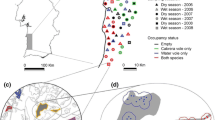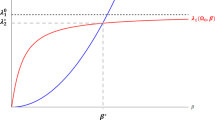Summary
The populations of two coexisting species of Dipodomys (Heteromyidae, Rodentia) were manipulated on 10, large, unenclosed, trapping grids. These manipulations revealed that, although many kangaroo rats are established residents in an area, a large number are transient individuals who quickly occupy vacated habitats. On plots from which residents had been removed, transients settled at rates of up to 5% of carrying capacity per day. These immigrants were invariably of the same species that was removed, indicating a strong element of intraspecific competition with little or no evidence of competition between the species.
Trapping records suggest that these species avoid competition through habitat selection. Dipodomys ordii prefer a grassier habitat, and D. merriami a habitat dominated by creosote bush. Apparent overlap in their utilization of habitats, based on sites of capture, predicts competition coefficients to be higher than those permitted by the theory of limiting similarity and much higher than those actually shown by the perturbation experiments.
This study demonstrates the dangers of estimating alpha without experimentation. This is especially true in cases where habitat selection may be important, since organisms may travel in habitats without collecting resources therein. Our results are discussed in light of a theory which examines the optimal (rather than tolerable) amount of overlap in habitat utilization between two potential competitors in a mixed habitat. This theory predicts that the pressure of natural selection should eliminate the interspecific competition entirely.
However, the conclusion that the interspecific competitive alpha is zero does not lead to the conclusion that interspecific competition is unimportant in the system. Instead, if our interpretation is correct, such competition has molded the system, and were there not a continual threat of interspecific competition, the habitat specializations would soon disappear.
Similar content being viewed by others
References
Andrewartha, H. G.: Introduction to the study of animal populations. Chicago: University of Chicago Press 1961
Bradley, W. G., Mauer, R. A.: Reproduction and food habits of Merriam's kangaroo rat, Dipodomys merriami. J. Mammal. 52, 497–507 (1971)
Brown, J. H.: Species diversity of seed-eating desert rodents in sand dune habitats. Ecology 54, 775–787 (1973)
Brown, J. H.: In: Ecology and evolution of species communities. Cambridge: Belknap Press, Harvard Univ. Press (in press)
Brown, J. H., Lieberman, G. A.: Resource utilization and coexistence of seed-eating desert rodents in sand dune habitats. Ecology 54, 787–797 (1973)
Christopher, E. A.: Sympatric relationships of the kangaroo rats, Dipodomys merriami and Dipodomys agilis. J. Mammal. 54, 317–326 (1973)
Dayton, P. K.: Two cases of resource partitioning in an intertidal community: making the right prediction for the wrong reasons. Amer. Natur. 107, 662–670 (1973)
Dunham, M.: A comparative food habitat study of two species of kangaroo rats, Dipodomys ordii and Dipodomys merriami. Master's Thesis, University of New Mexico (1968)
Eisenberg, J. F.: The behavior of heteromyid rodents. Univ. California Publ. Zool. 69, 1–114 (1963)
Eisenberg, J. F., Isaac, D. E.: The reproduction of heteromyid rodents in captivity. J. Mammal. 44, 61–67 (1963)
Grant, P. R.: Interspecific competition among rodents. Ann. Rev. Ecol. Syst. 3, 79–106 (1972)
Krebs, J. R.: Territory and breeding density in the great tit, Parus major L. Ecology 52, 2–23 (1970)
Levins, R.: Evolution in changing environments. Princeton: Princeton Univ. Press 1968
MacArthur, R. H.: The ecologist's telescope. Ecology 50, 353 (1969)
MacArthur, R. H.: Geographical ecology. New York: Harper and Row 1972
MacArthur, R. H., Levins, R.: The limiting similarity, convergence, and divergence of coexisting species. Amer. Natur. 101, 377–385 (1967)
MacArthur, R. H., Pianka, E. R.: On optimal use of a patchy environment. Amer. Natur. 100, 603–609 (1966)
May, R. M., MacArthur, R. H.: Niche overlap as a function of environmental variability. Proc. nat. Acad. Sci. (Wash.) 69, 1109–1113 (1972)
Miller, R. S.: Patterns and process in competition. Advances in ecological research, J. B. Cragg, ed., vol. 4, p. 1–74. London: Academic Press 1967
Pulliam, H. R.: On the theory of optimal diets. Amer. Natur. 108, 59–74 (1974)
Rosenzweig, M. L.: Dynamic of populations, p. 295, P. J. den Boer, G. R. Gradwell, eds. Wageningen: Center Agri. Pub. and Doc. 1971
Rosenzweig, M. L.: Habitat selection experiments with a pair of coexisting heteromyid rodent species. Ecology 54, 111–117 (1973)
Rosenzweig, M. L.: On the evolution of habitat selection. Proceeding of the first international congress in ecology. Wageningen: Center for Agricultural Publishing & Documentation 1974
Rosenzweig, M. L., Smigel, B., Kraft, A.: Patterns of food, space and diversity. In: Rodents in desert environments, I. Prakash, P. K. Ghosh, eds., Monogr. Biol. The Hague: Junk (in press)
Rosenzweig, M. L., Winakur, J.: Population ecology of desert rodent communities: habitats and environmental complexity. Ecology 50, 558–572 (1969)
Smigel, B. W., Rosenzweig, M. L.: Seed selection in Dipodomys merriami and Perognathus penicillatus. Ecology 55, 329–339 (1974)
Vorhies, C. T., Taylor, W. P.: Life history of the kangaroo rat Dipodomys s. spectabilis. USDA Bull. 1091 (1922)
Author information
Authors and Affiliations
Rights and permissions
About this article
Cite this article
Schroder, G.D., Rosenzweig, M.L. Perturbation analysis of competition and overlap in habitat utilization between Dipodomys ordii and Dipodomys merriami . Oecologia 19, 9–28 (1975). https://doi.org/10.1007/BF00377586
Received:
Issue Date:
DOI: https://doi.org/10.1007/BF00377586




